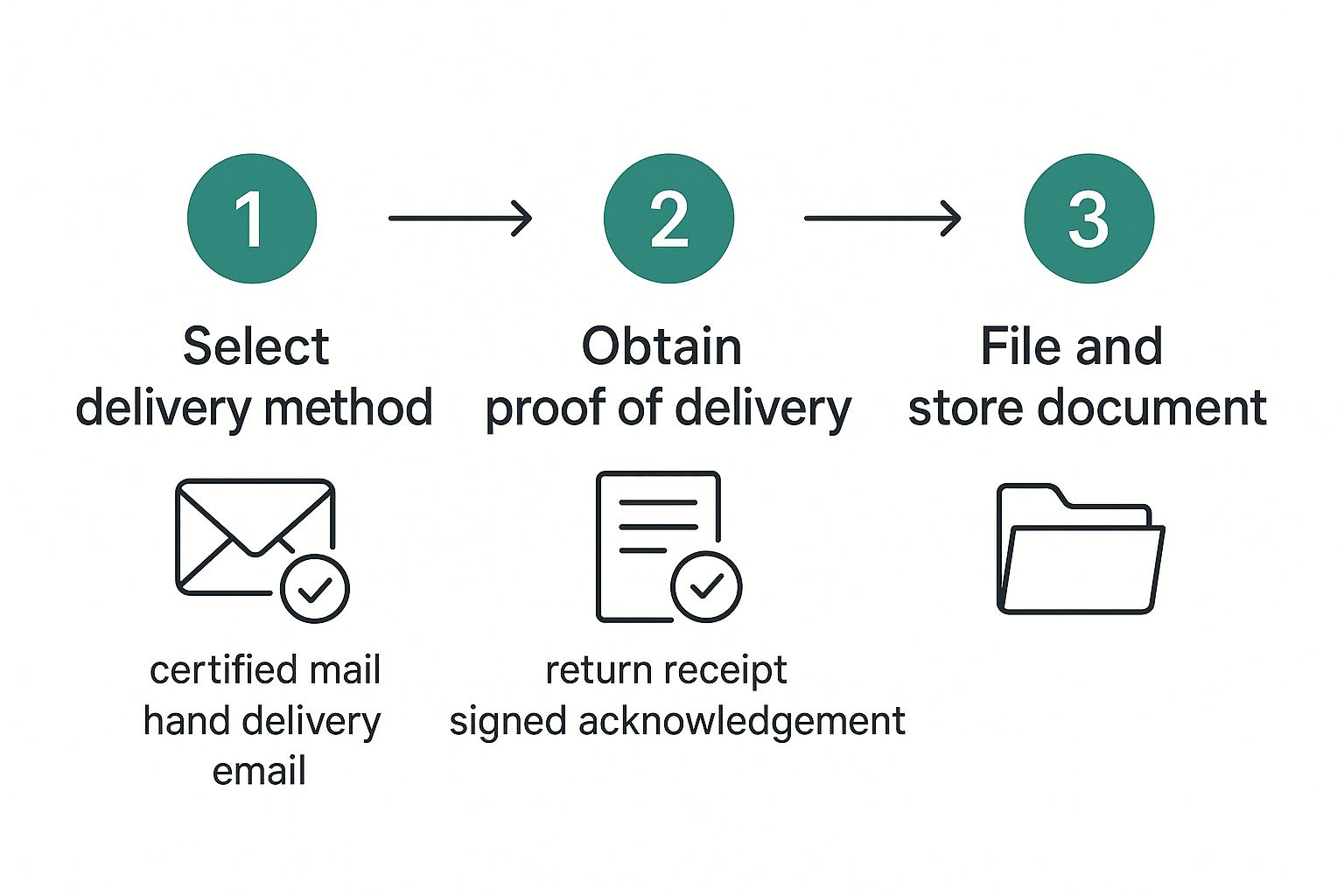A 60-day notice to vacate letter isn't just a courtesy—it's a formal, often legally required document you provide to your landlord, signaling your intent to move out in two months. Think of it less as a simple "I'm moving" note and more as the official start of the move-out process, governed by your lease and local laws.
First, Do Your Homework
Before you even think about drafting the letter, your first move should always be to pull out your original lease agreement. This document is your tenancy's instruction manual. It spells out the exact terms you agreed to, including the all-important notice period.
Don't just assume it's 60 days. I've seen leases that require 30, 90, or something else entirely. Getting this detail wrong from the get-go can lead to a world of hurt, from forfeited security deposits to extra rent charges. It’s a simple but critical first step.
After you've got a handle on your lease, you'll need to check your local and state housing laws. Sometimes, these regulations can actually override the terms in your rental agreement.

Scour Your Lease for Key Clauses
Carefully read through your lease, looking for sections with headings like "Termination," "Notice to Vacate," or "Move-Out." These paragraphs hold the answers you need.
Specifically, look for:
- The Notice Period: Does it explicitly say 60 days, or is it another timeframe?
- How to Deliver It: Your lease might require you to send the notice via certified mail or even hand-deliver it. An email might not cut it legally, so don't take any chances.
- Early Termination Fees: If you're leaving before your lease is up, you need to know what you're on the hook for financially. In these cases, it might be worth looking into an apartment lease buyout to manage the costs.
Doing this bit of detective work upfront is the best way to protect yourself. It ensures your notice is legally sound and helps you avoid any nasty surprises down the road.
Get Familiar with Local and State Tenant Laws
Landlord-tenant laws can change dramatically from one state, or even one city, to another. While a 30-day notice is pretty standard for many month-to-month leases in the U.S., at least 13 states mandate a 60-day notice if you've been a tenant for more than a year.
California, for example, has Civil Code Section 1946.1, which makes this longer notice period a legal requirement for anyone who has lived in a rental for 12 months or more. This is a perfect example of a state law superseding what might be in a generic lease.
Key Takeaway: Your lease is your starting point, but state and local laws are the final word. A quick online search for "[Your State] tenant notice period" will give you the clarity you need and help prevent any potential legal headaches.
Finally, remember that moving out involves more than just sending a letter. Once the notice is in, start planning the logistics. Thinking ahead about things like hiring professional move-out cleaning services can make a huge difference in getting your full security deposit back. Taking these proactive steps will set you up for a smooth, stress-free move.
What Absolutely Must Go in Your 60-Day Notice to Vacate
Think of your notice to vacate letter as a critical legal document. Getting it right is non-negotiable. Any fuzzy details or missing information can create headaches down the line, from arguments with your landlord to delays in getting your security deposit back. A clear, complete letter is your best tool for a smooth exit.
The whole point is to officially record your intention to move out, leaving zero room for interpretation. This protects you just as much as it helps your landlord plan.

Nail the Basics: Who, What, and When
First things first, let's cover the foundational details. It might seem obvious, but you’d be surprised how often people miss these, potentially voiding their notice.
At the very top, you need to include:
- Your Full Name & Current Address: Make sure to use the exact name on your lease and don't forget your unit number.
- Landlord's Name & Address: Address it to the right person or property management company, using the official address from your lease agreement.
- The Date You're Writing It: This is huge. The date you send the letter is what kicks off your 60-day countdown.
Getting these identifiers right establishes the "who" and "when" of the notice, preventing any confusion, especially if you live in a large complex with tons of tenants. If you need a refresher on why these details carry legal weight, our guide on understanding a lease agreement is a great resource.
The Heart of the Letter: Your Intent and Move-Out Date
This is the most important sentence in the entire document. You have to be crystal clear that you're leaving. This isn't the place for soft language.
A direct statement like, "This letter serves as my formal 60-day notice that I will be vacating the property," is perfect. It's direct, professional, and gets the job done.
Right after that, state the exact date you plan to be completely moved out and will return the keys. For instance, if you're sending the notice on October 1st, your move-out date would be November 30th. Pinpointing this date is crucial for your landlord to start marketing the property and for you to schedule your move.
An Expert Tip from Experience: Be careful when you calculate the 60 days. The clock starts when your landlord receives the notice, not when you mail it. I always recommend adding a day or two to your calculation, just to be safe.
Tying Up Loose Ends
To finish strong, include a few key details to help wrap up your tenancy without any drama. This shows you're organized and considerate, which can go a long way in getting your full security deposit back quickly.
Before you sign off, be sure to provide:
- A Forwarding Address: This is where the landlord will mail your security deposit check. Don't make them hunt you down.
- Your Contact Info: A good phone number and email address are essential so they can reach you with any questions during or after you've moved.
To make sure you don't miss a thing, I've put together a quick checklist. Run through this before you send your letter.
Essential Information Checklist for Your Notice
This table breaks down exactly what you need and why it's so important.
| Component | Why It's Important | Example |
|---|---|---|
| Current Date | Establishes the official start of the 60-day notice period. | "October 1, 2024" |
| Your Full Name & Address | Clearly identifies you as the tenant and specifies the property. | "Jane Doe, 123 Main Street, Apt 4B" |
| Landlord/Property Manager's Name & Address | Ensures the notice is delivered to the correct legal entity. | "ABC Property Management, 456 Oak Avenue" |
| Clear Statement of Intent | Leaves no room for misinterpretation about your decision to move. | "This letter is my official 60-day notice to vacate." |
| Specific Move-Out Date | Provides a definitive end date for your tenancy. | "I will vacate the premises on or before November 30, 2024." |
| Forwarding Address | Tells the landlord where to send your security deposit and any final mail. | "Please send my security deposit to: 789 Pine Lane, Anytown, USA 12345" |
| Your Contact Information | Allows for easy communication during the move-out process. | "I can be reached at (555) 123-4567 or jane.doe@email.com." |
By making sure your letter has all these components, you’re not just sending a note—you're providing a clear, professional document that fulfills your legal duties and paves the way for a smooth, conflict-free move.
How to Actually Write Your 60-Day Notice
Alright, you've got all your details lined up. Now comes the part where you put pen to paper (or fingers to keyboard) and write your 60-day notice to vacate. We're going to move past those cookie-cutter online templates. The real goal here is to nail the right tone—professional, clear, and respectful. Getting this right can make a world of difference in how your last two months go and whether you get your full security deposit back without a headache.
The words you choose really matter. A letter that's polite and gets straight to the point prevents any confusion and sets you up for a smooth, cooperative move-out process.
Nailing the Opening
You want to start off on the right foot. Your opening should be direct but not cold. A simple, professional greeting like "Dear [Landlord's Name]," or "To [Property Management Name]," works perfectly to establish a respectful tone from the get-go.
Right after the greeting, cut to the chase. Your very first sentence needs to clearly state why you're writing. Don't leave any room for interpretation.
Here are a couple of ways you could phrase it:
- For a direct approach: "Please accept this letter as my official 60-day written notice to vacate the premises at [Your Full Address, including Unit Number]."
- For a slightly softer feel: "This letter is to inform you of my intention to end my tenancy at [Your Full Address, including Unit Number], with my lease terminating 60 days from [Date of Notice]."
Both of these get the job done. They clearly communicate your intent while keeping things professional. The main takeaway is to be completely unambiguous right from the start.
Building the Body of the Letter
The middle of your notice is where you'll lay out the critical details. The most important thing here is to state your exact move-out date again. Be specific. For example, "My final day in the apartment will be [Your Move-Out Date]."
This is also a good spot to briefly mention why you're leaving, but remember, this is totally optional. Most of the time, less is more.
A Quick Tip From Experience: You are under no obligation to give a detailed life story. A simple, vague reason like "I'm relocating for a new job" or "I've purchased a home" is plenty. Honestly, giving no reason at all is also perfectly fine and often the smartest move.
It's also a good idea to show you're willing to play ball during the transition. Adding a sentence like, "I am happy to cooperate with showings for new tenants, provided I receive reasonable notice," shows a lot of goodwill. This small gesture can make your final two months much less stressful and helps maintain a positive relationship.
Wrapping It Up: The Forwarding Address and Signature
How you end your letter is just as crucial as how you begin. This is your last chance to provide the information your landlord needs to close out your account properly.
The single most important piece of information here is your forwarding address. State it plainly: "Please send my security deposit and any final correspondence to my new address: [Your Full Forwarding Address]." Forgetting this can cause major delays in getting your deposit back.
This isn't just a U.S. thing, by the way. Structured notice periods are common globally. In the UK, for example, a standard two-month notice—very similar to a 60-day notice to vacate—was historically required for the nearly 80% of private rentals under assured shorthold tenancies. As of 2020, that covered about 4.6 million households. It just goes to show how important these formal notices are. If you're curious, you can learn more about how different rental markets work in this Redfin guide on the topic.
Finally, sign off professionally with "Sincerely," followed by your signature and your printed full name. That signature is what makes it an official, legally recognized document. It's a small detail, but forgetting to sign can sometimes invalidate the entire notice.
Making Sure Your Notice Is Delivered and Documented
You’ve drafted the perfect 60 day notice to vacate letter, but your work isn't done just yet. A letter, no matter how well-written, is legally powerless until it’s officially in your landlord's hands. How you deliver it is just as critical as what you wrote, because that delivery method creates the paper trail that protects you from any future arguments.
Think of it like this: your notice is the message, but proof of delivery is the receipt. Without that receipt, it's your word against your landlord's. That's a messy situation, especially when you're trying to get your security deposit back.
Choosing Your Delivery Method
You have a few ways to get this done, but they aren't all equal in a legal sense. Your first stop should always be your lease agreement—it might actually tell you exactly how you're required to send notices.
-
Certified Mail with Return Receipt: This is the undisputed champion. It gives you a tracking number and, more importantly, a signed confirmation card (the return receipt) that shows who signed for the letter and on what date. It’s rock-solid, undeniable proof.
-
Hand-Delivery: This can work, but you have to be careful. Never just slide it under the door and hope for the best. You need to hand it directly to your landlord or property manager and have them sign and date a copy of the notice for you right then and there. That signed copy is now your proof.
-
Email: Email is fast, but it’s also risky. It’s only a safe bet if your lease explicitly allows notices via email, or if your landlord replies and acknowledges they received it. If they don't reply, you have no proof they ever opened it.
Sending your notice via certified mail is a small step that provides immense peace of mind. If you've never done it before, you can find simple guides on how to send a certified letter that walk you through the process.
This infographic breaks down the key steps to make sure your notice is delivered successfully.

As you can see, the process doesn't stop once you drop the letter in the mail. It's only truly finished when you have that irrefutable proof of delivery filed away.
Creating an Undisputable Paper Trail
Once the notice has been delivered, there's one final step. You need to organize your documentation meticulously. This file is your evidence if anyone ever questions when your 60-day clock officially started.
Key Takeaway: Your file should have two crucial things: a copy of the signed 60 day notice to vacate letter you sent and your proof of delivery—either the green certified mail receipt or the copy of the notice your landlord signed.
Keep these documents together in a safe place, maybe in the same folder as your original lease agreement. It might seem like a small detail, but this level of organization is your best defense. This proof is often the deciding factor in getting your security deposit returned in full and on time. For a deeper dive, our guide on what is a security deposit explains how this process works and how you can protect your money.
Common Mistakes That Can Invalidate Your Notice

Sending your 60 day notice to vacate letter feels like crossing the finish line, but one simple slip-up can send you right back to the start. A seemingly minor mistake can invalidate the entire notice, and that could easily cost you another month's rent or even your security deposit. It’s critical to give this letter the same careful attention you gave your original lease.
One of the most common blunders I've seen is miscalculating the 60-day period. People often forget that the clock usually starts ticking the day your landlord receives the letter, not the day you pop it in the mail. For instance, if you mail it on October 1st and it doesn't land in their hands until October 3rd, your 60 days begin from the 3rd. You have to be meticulous here.
Another trap is getting too casual. Firing off a quick text or email feels easy, but unless your lease specifically says that's an acceptable method, it likely won't hold up. Without that formal, written notice, a landlord could argue they were never officially told you were leaving, putting you in a real bind.
Forgetting Key Details
Missing information is probably the fastest way to have your notice dismissed. When you're juggling all the logistics of a move, it's surprisingly easy to forget the basics.
Before you send anything, give it a final once-over to make sure you've included these deal-breakers:
- Your Signature: An unsigned letter is essentially worthless from a legal standpoint. Your signature is what makes it an official notice.
- The Current Date: This is what anchors your timeline. Without it, there’s no clear starting point for the 60-day countdown.
- A Specific Vacate Date: Phrases like "we'll be out sometime in two months" are a no-go. You need to state the exact, final day you will be surrendering the property.
They seem like such small things, but their absence can completely undermine your notice. My advice? Always use a checklist to review your letter before it goes out the door.
Key Takeaway: Think of your notice not just as a heads-up, but as a legal document with a firm deadline. If it fails to meet the legal requirements for content and delivery, your landlord can legally ignore it, forcing you to start the whole process over again.
The Dangers of Verbal Agreements
Putting your faith in a verbal "okay" from your landlord is a huge risk. You might have a great, friendly relationship, but things change. The property could be sold, a new management company could take over, or your landlord could simply forget your conversation ever happened.
When it's your word against theirs, a lack of written proof leaves you with zero leverage. This is precisely why a formal 60 day notice to vacate letter, sent via a trackable method like certified mail, is your greatest protection. It creates a solid paper trail, proving you did everything by the book. That documentation is your safety net, paving the way for a smooth, conflict-free move.
Your Top Questions About Giving Notice, Answered
When it's time to move on from your apartment, a few key questions always seem to pop up. It’s completely normal. Getting the details right is a big deal, because a simple mistake can end up costing you money or adding a ton of stress to your move.
Let's walk through the most common questions renters ask when they're getting ready to send a 60-day notice to vacate letter. We'll clear up the confusion so you can feel confident you're handling things the right way.
What Happens If I Miss the 60-Day Deadline?
This is a big one. If you don't give the full 60 days' notice that your lease requires, you'll almost certainly be on the hook for the rent covering that entire period, even if you’ve already moved your boxes out.
For example, say you only give 45 days' notice. Your landlord can likely charge you for the extra 15 days to complete the full 60-day term. It can also put your security deposit at risk. If you realize you're running late, the best thing you can do is talk to your landlord right away. Honesty and a quick conversation can go a long way.
Can My Landlord Just Reject My Notice?
In most cases, no. A landlord can't simply "reject" a notice that you’ve written and delivered correctly, especially if you're on a month-to-month lease or ending a fixed-term lease at the proper time. Think of your notice as a formal declaration, not a request. You're informing them of your decision to leave according to the terms you both agreed to.
But here’s the critical part: they can challenge the notice if it isn't valid. This might happen if it’s missing key information, you sent it the wrong way (e.g., a text when the lease requires a letter), or you're trying to break a long-term lease without a valid reason. This is exactly why getting every detail right is so important.
Do I Still Have to Pay Rent for Those Last 60 Days?
Yes, without a doubt. Handing in your 60-day notice to vacate letter doesn't pause your rent payments. You're still legally required to pay for the entire 60-day period, which covers your last two months living in the apartment.
Skipping out on that final rent payment is a serious breach of your lease. It could result in legal headaches and damage your rental history, which can make it a lot tougher to find a new place down the road. Make sure you budget for those last two rent checks.
Ready to find your next home in a community that values clear communication and comfortable living? Cynthia Gardens offers beautiful, serene one-bedroom apartments in the heart of Boca Raton. Explore our available units and see why so many choose to call us home at https://cynthiagardens.com.
